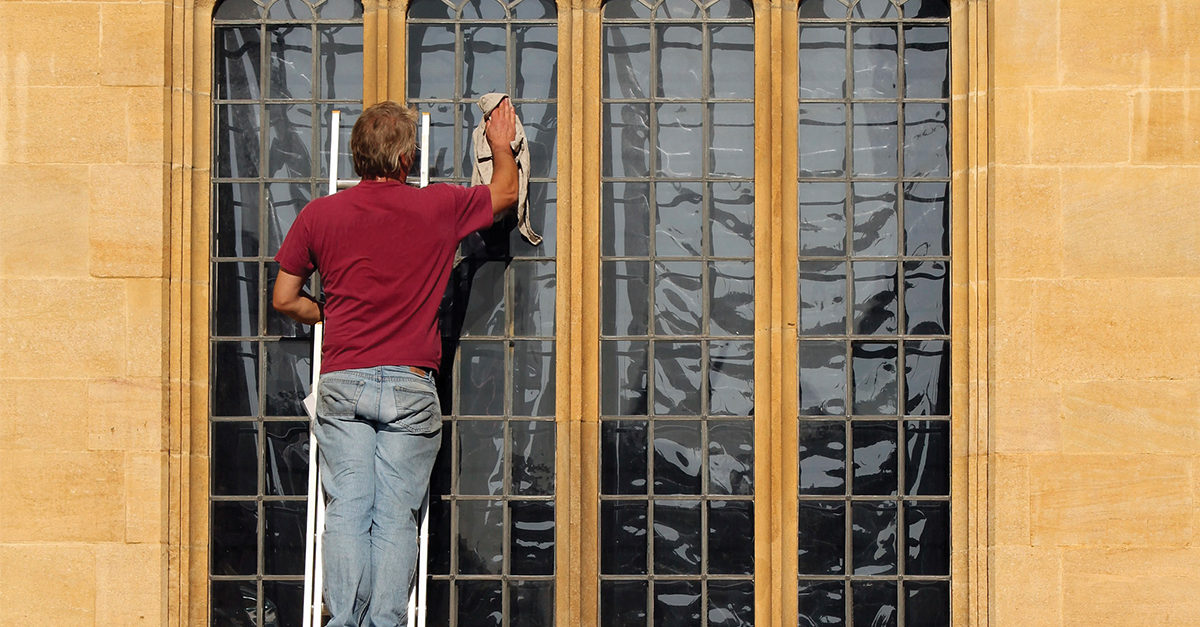To successfully organize (or reorganize) a higher education custodial department, one must first answer the question: What is the purpose or mission of our custodial department?
If the purpose of the organizational effort is to make educational facilities appear orderly and clean at the lowest cost, that drives a different set of actions than if the goal was to clean for health and other related results.
Since most agree that cleaning’s value should be defined by more than appearance, the cleaning performance metrics below are important to consider, both in aggregate and as parts of a greater whole:
- Appearance metrics
- Customer satisfaction metrics
- Fiscal metrics
- Sanitizing metrics
- Health metrics.
These five metrics, or key performance indicators (KPIs), affect educational facilities of all types, help define quality end points, and embody goals to work toward. Later in the article, we’ll explain what the metrics mean, how to define them, and how these targets can help operations better organize activities to achieve goals and customer satisfaction.
The Purpose of Cleaning
In order to perform at their best, custodial crews working in higher education need to ask themselves, with input from other building staff and administrators, the following questions:
- “What do we want to be?”
- “What do we want to be the best at?”
- “What identity, title, or acronym, best describes our role?”
However, while answering these questions, remember: Only facility results or consistent outcome metrics bring meaning to mission statements, programs, written standards, and titles.
Organizing to Deliver on Metrics
The following questions relate to the goal of doing more with less: What exactly do we want more of, and what exactly do we want less of?
For example, do we want more cleaning done in less time? Do we want fewer overall labor hours? Do we want more non-chemical interventions, such as dry-steam vapor, and less use of conventional chemistry? What are the related KPIs—the numbers or data—to know we are doing more of the right things and using less resources?
In other words, what numerical goals are we trying to achieve? Examples can include:
- Raising productivity and lowering the cost of labor by 30 percent, while reducing the time it takes to clean a school building by two hours per shift
- Increasing the frequency of desktop cleaning in classrooms to daily, while lowering the average level of organic soil by 50 percent, as measured weekly by handheld adenosine triphosphate (ATP) devices
- Increasing the use of microfiber and electrolyzed water by 50 percent, while lowering the expenditure on standard cleaning chemicals by US$50,000 annually per district.
Inevitably, the numbers your higher education custodial department wants to pinpoint will include those that relate to the bottom line. In fact, the more they do, the more you can justify your department’s budget.
Factors that affect the monetization of your department include:
- How things look and smell (appearance metrics)
- The happiness of your customers (customer satisfaction metrics)
- The cost of cleaning (fiscal metrics)
- The hygiene and health of the school facilities (sanitizing and health metrics).
Let’s examine each of the five performance metrics mentioned above to define them in broad terms, help drive clarity of purpose, and organize our operations for results.
Appearance Metrics
“How do things look?” is a question we may ask of administrators, staff, and students, but it hardly provides a numerical goal to work toward.
Since this metric relates to customer satisfaction, it can be determined by a simple inspection, cleaning evaluation software, and customer surveys with assigned points for task results. The goal is high-point scores indicating customer satisfaction.
Ask the customer or tenant to rate the level of cleanliness on a scale from one to 10, with 10 being best. While this is indeed subjective, the nature of customer perception is subjective; they will judge the quality of your cleaning based on what they see and smell. This metric measures these impressions in a fair and objective way by averaging the viewpoint of perhaps 25 percent of facility users, plus a third-party auditor or assessor (via an unannounced visit).
Strive for daily, weekly, or monthly inspection, assigning points from one to 10 for each item, with 10 being best, and performance receiving rates of nine or 10.
Customer Satisfaction Metrics
This metric (like appearance data) specifies end points for aspects of the quality system required for operations that are certified by the ISSA Cleaning Industry Management Standard (CIMS). Strive for regular surveys of customers, using the same point scale as above.
For example, on a scale from one to 10, with 10 being best, is the customer happy with the cleaning and the cleaning staff’s responsiveness to input or complaints? This metric is no more complicated than that. While this is indeed subjective, perception is reality, and if customers are generally happy with the service, the surveys should reflect that.
Fiscal Metrics
Accurately knowing, optimizing, and often, lowering, the cost of cleaning comes from understanding several numbers:
- Cleanable square feet or meters
- Overall cost of cleaning
- Cost per square foot of cleaning
- Square feet cleaned per full time custodial worker.
American School and University (AS&U) magazine periodically surveys schools and compiles data on costs associated with facility maintenance, including cleaning and custodial departments. For example, the 38th Annual AS&U Maintenance & Operations Cost Study determined on average, 32,100 square feet per shift are cleaned by each custodial worker.
AS&U noted with increasing pressures on custodial departments to clean more with fewer labor resources, “facility directors must look continually for ways to improve productivity so that staff can work smarter, safer, and more efficiently.”
Well-defined cleaning systems consistently raise the number of square feet cleaned per full-time custodial worker, while reducing the costs of cleaning and increasing customer satisfaction. One system reports productivity as high as 35,000-40,000 square feet (or more) cleaned per full-time custodial worker.
Asset preservation also fits into a fiscal metric. Clean surfaces last longer, so factors should be developed to measure this for better targeting and organizing of efforts.
Sanitizing Metrics
A useful sanitizing metric shows reduction of ATP levels as an indicator of organic soil (microbes or food for microbes) presence. ISSA’s Clean Standard: K-12, “a framework that to help schools and other institutional facilities objectively assess the effectiveness of their cleaning processes,” uses this metric.
Proper and consistent use of handheld ATP devices (including a repeatable swabbing technique) for measurement is important to identifying trends and best practices (see ATP Meters – Six Steps to Proficiency, published by the Healthy Facilities Institute). Less germ-promoting soil as measured by lower ATP levels means fewer points of disease transmission.
According to ISSA’s How Dirty is Your Child’s School infographic, “Cleanliness is usually defined by visual inspection.” However, “When standards are used to measure cleanliness, health can improve.”
ISSA’s Clean Standard is an emerging standard that defines lower target-levels of ATP after cleaning. Achieving these target numbers, or getting closer to them, should equate to healthier school environments.
Health Metrics
Beyond the common-sense knowledge that measurably cleaner surfaces can help prevent transmitting infectious disease, it is also believed that better cleaning leads to lower absenteeism, translating into more funding for schools and better learning for students.
While anecdotal data supports this belief, hard data associated with cleaning reducing absenteeism is harder to pinpoint because of confounding variables, such as ventilation, individual differences among people, and preexisting conditions, but it only makes sense that a cleaner indoor environment supports better health, attendance, and learning in schools. Controlled studies are needed before correlated metrics can be provided with scientific assurance, but meanwhile, we should keep looking for supporting trends and related information to drive healthier methods.
For example, if trying to implement either sanitizing or health metrics to build customer satisfaction, create an average score based on:
- The healthiness of the facility based on customer and auditor-walk-through surveys
- The healthiness of the facility based on average daily attendance (ADA) numbers, where available
- The healthiness of the facility based on average ATP post-cleaning numbers.
Additionally, settled dust levels are an indicator of what is airborne and inhalable. Lower levels of settled dust equates to lower levels of airborne dust as a possible trigger of asthma and allergies. Again, while customer perception is subjective, human visual acuity, olfactory, and other senses are quite sensitive and can detect dust, odor, and other contaminants without the need for scientific devices. This perception, when averaged across enough users of the facility and unannounced third-party audits, can contribute to the accurate sense of clean and healthy, with more scientific assessments pending further development of the Clean Standard.
The health metric also needs a disclaimer that states it is not a scientific measurement, but reflects customer and auditor impressions and sensibilities. There can be a requirement for meeting certain Leadership in Energy and Environmental Design (LEED) metrics for use of green, sustainable products, but this, like other metrics, is from a customer-centric view. Involving operations staff in discussion of HVAC filtration and other indoor environment factors enables true collaboration for cleaner, healthier environments with greater customer satisfaction and well-being.
Systems Govern
The guiding principle to correct disorganized operations was stated by Dr. W. Edwards Deming as, “People do not fail, systems do.” How can we successfully apply a systems-model to organize a custodial department?
Several of Deming’s 14 key principles for management, which can be found on The W. Edwards Deming Institute’s website, apply:
- “Improve constantly and forever the system of production and service, to improve quality and productivity, and thus constantly decrease costs.”
- “Cease dependence on inspection to achieve quality. Eliminate the need for inspection on a mass basis by building quality into the product [or service] in the first place.”
- “Institute training on the job.”
- “Institute a vigorous program of education and self-improvement.”
The business axiom, “What is measured gets done,” applies with equal force to higher education custodial operations seeking measurable ways to define and target improvement. Organizing and reorganizing custodial departments using key metrics or numbers can help professionalize cleaning efforts, help operations do more with less, and help them succeed in the fiscally disciplined environment of higher education facilities maintenance.
Rex Morrison is president of the nonprofit Process Cleaning for Healthy Schools (PC4HS) group. He is also a CIMS ISSA Certification Expert (I.C.E.) who provides training and consulting services to cleaning organizations interested in complying with and preparing to be certified to the ISSA Cleaning Industry Management Standard (CIMS).
How Well is My Team Cleaning?
Surveying customers is one way to find out how well your team is cleaning. But what items should you list in the survey?
Visit www.cmmonline.com/online-exclusives to access a sample of a service assessment/inspection form, which can help to determine the effectiveness of your cleaning in schools, and how your customers feel about the results.




